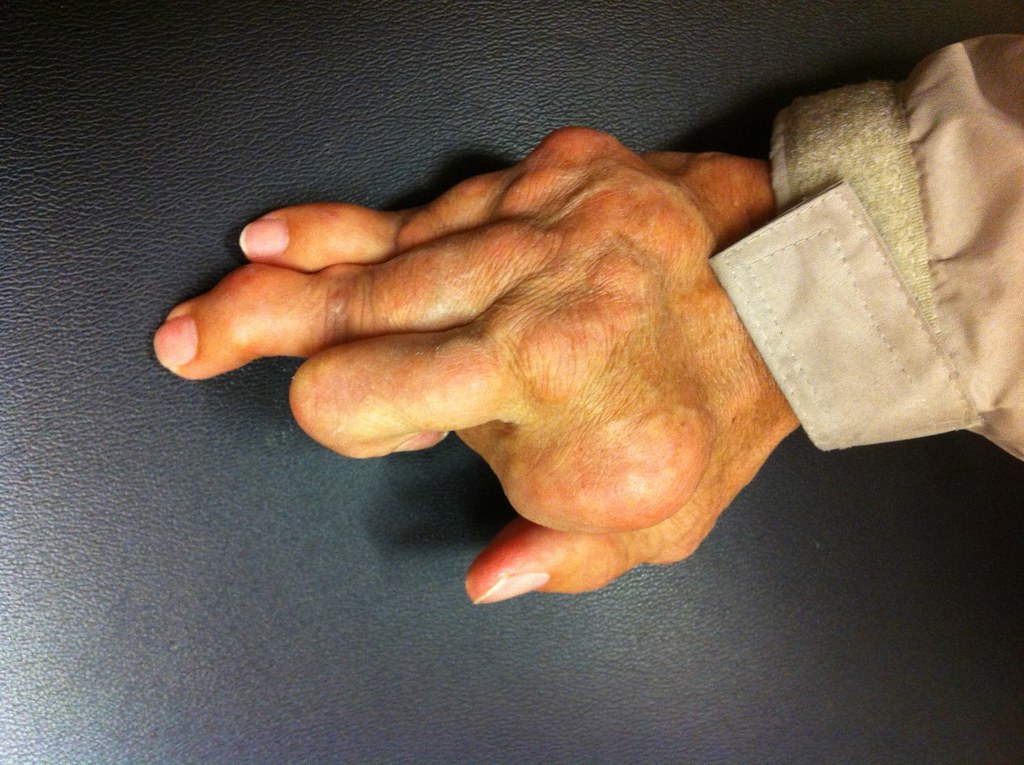FTC disclaimer: This post may contains affiliate links and we will be compensated if you click on a link and make a purchase.
Rheumatoid arthritis (RA) is akin to an unwelcome squatter in the body’s joints, bringing along a chronic inflammation that not only wreaks havoc within the joints but also can impact various organs, leading to widespread complications.
This autoimmune condition, often fueled by a genetic predisposition mingling with environmental factors such as smoking, is notorious for its symmetrical assault on small peripheral joints before potentially advancing to larger joints.
The consequences of untreated RA can be severe, leading to joint destruction, cartilage loss, and even increased mortality.
This article aims to serve as a beacon of knowledge, guiding readers through the intricacies of diagnosing and managing rheumatoid arthritis.
By arming oneself with an understanding of RA’s pathophysiology, treatment strategies, and the importance of collaborative care, individuals can navigate towards an improved quality of life.
The journey to manage RA effectively is not a sprint; it’s a marathon—with the right knowledge and tools, patients and healthcare providers can run it together.
For further information on the subject, please refer to the National Center for Biotechnology Information (NCBI) Bookshelf.
Understanding Rheumatoid Arthritis
Rheumatoid arthritis (RA) is an autoimmune disorder that primarily attacks the joints but can also affect other systems.
Unlike the wear-and-tear damage of osteoarthritis, RA affects the lining of your joints, causing painful swelling that can eventually result in bone erosion and joint deformity.
The exact cause of RA remains a mystery, though it’s believed to involve a combination of genetic predisposition and environmental factors.
RA is more prevalent in women and typically manifests in middle age. Smoking, obesity, and certain genetic markers are known risk factors that can exacerbate the condition.
Interestingly, breastfeeding may offer a protective effect against developing RA.
Unlike other forms of arthritis, RA is characterized by symptoms on both sides of the body, such as both knees or both wrists and can lead to complications beyond the joints, including heart and lung problems.
For those grappling with joint pain and seeking clarity, it’s crucial to distinguish RA from other joint afflictions.
RA’s signature move is symmetrical joint involvement and systemic inflammation, setting it apart from its arthritis cousins.
If you suspect RA is the unwelcome guest causing your joint woes, it’s time to turn to a rheumatologist, the detective of musculoskeletal mysteries, who can confirm the diagnosis and partner with you on the path to management and relief.
Diagnosing Rheumatoid Arthritis
Embarking on the journey to diagnose Rheumatoid Arthritis (RA) can feel like navigating through a maze with hidden clues.
It begins with a physical exam, where a doctor assesses joint swelling, tenderness, and mobility. Given that RA is an artful impersonator, mimicking the symptoms of other conditions, a definitive diagnosis often hinges on a combination of blood tests and imaging tests.
Blood Tests
Blood tests play a pivotal role, as they search for inflammatory markers such as Erythrocyte Sedimentation Rate (ESR) and C-reactive protein (CRP), alongside specific antibodies like Rheumatoid Factor (RF) and Anti-CCP.
These antibodies are the body’s misguided security personnel, attacking its own tissues and signaling the presence of RA. However, not all RA warriors bear these markers, making the hunt for a diagnosis more complex.
Imaging Tests
Imaging tests such as X-rays or MRI scans capture the extent of joint damage, often silent in the early stages.
Recognizing RA’s stealthy nature, the medical community underscores the importance of an early diagnosis to prevent joint damage and maintain quality of life.
Therefore, one should never self-diagnose; instead, visiting a rheumatologist is critical for a tailored battle plan against this chronic adversary.
Treatment Options for Rheumatoid Arthritis
Treating rheumatoid arthritis (RA) is akin to tailoring a suit; it must be customized to fit perfectly.
Medications
The therapeutic arsenal includes medications like NSAIDs, corticosteroids, and disease-modifying antirheumatic drugs (DMARDs), such as Methotrexate and biologics.
These medications aim to reduce inflammation and prevent joint damage. However, each comes with potential side effects, from liver damage to increased infection risk, making a careful balance of benefits and risks crucial.
Lifestyle changes
RA management is not just about popping pills; it’s also about lifestyle adjustments. Simple changes, such as using assistive devices for daily tasks, can spare your joints.
Furthermore, embracing activities like tai chi may improve both mood and mobility. Yet, always consult with a healthcare professional before starting new therapies to ensure they complement your treatment plan and don’t interfere with medications.
Ultimately, a successful RA treatment strategy is a team effort, requiring open communication with your healthcare team to craft a plan that enhances your quality of life.
Managing Rheumatoid Arthritis Symptoms
Living with Rheumatoid Arthritis (RA) can be challenging, especially when dealing with pain, stiffness, and swelling.
To manage these symptoms, it’s crucial to stay active. Engaging in regular physical activity can help maintain joint flexibility and reduce pain.
The Arthritis Foundation Exercise Program is specifically designed to support individuals with arthritis in safely increasing their physical fitness.
Alongside exercise, consider integrating alternative therapies into your routine. Acupuncture and massage have been shown to offer potential benefits, such as pain relief and improved quality of life.
However, it’s important to consult with your healthcare provider before starting any new therapy to ensure it aligns with your overall treatment plan.
- Explore gentle exercise options, such as tai chi or swimming, to keep your body moving without overstraining joints.
- Embrace assistive devices to protect your joints during daily tasks.
- Consider self-management education classes to enhance your ability to live well with RA.
Remember, every individual’s experience with RA is unique, so tailor these strategies to fit your personal needs and lifestyle for optimal symptom management.
Coping and Support
Rheumatoid arthritis (RA) can be a rollercoaster, not just physically, but emotionally too. It’s not uncommon to feel a cocktail of fear, resentment, or even hopelessness.
But there’s a silver lining—support groups can be a beacon of hope, improving mood and teaching pain-coping skills.
Research underscores the value of finding a group that aligns with your needs, whether it’s a peer-led circle or a more structured, educational setup.
But how do you manage day-to-day with RA? Here’s a snippet of wisdom: conserve your energy.
That might mean breaking tasks into bite-sized chunks or even sitting on a stool while whipping up your famous spaghetti sauce.
And remember, on days when RA seems like a distant memory, resist the urge to climb every mountain—pace yourself to avoid a flare-up the next day.
- Explore relaxation techniques like yoga and meditation.
- Connect digitally with others who understand the RA journey.
- Look for local or online support groups, such as the Arthritis Foundation’s Live Yes! Connect.
With the right support and smart strategies, living with RA can be less about coping and more about thriving.
The Role of Diet and Nutrition
Managing rheumatoid arthritis (RA) may be as much about what’s on your plate as it is about medical treatments.
Certain foods and nutrients, like the omega-3 fatty acids found in fatty fish, have been shown to reduce inflammation and may help manage RA symptoms.
On the flip side, maintaining a healthy weight is crucial, as excess body fat can increase the risk of developing RA and exacerbate its activity.
To weave a balanced and nutritious diet into your lifestyle, consider these tips:
- Embrace the heart-healthy Mediterranean Diet, rich in fruits, vegetables, and lean proteins.
- Reduce intake of red meat, saturated fats, and sugars that may contribute to inflammation.
- Monitor your caloric intake to prevent weight gain, which can stress joints and increase disease activity.
Remember, a diet that’s good for your joints is good for your overall health. Consult your healthcare provider for personalized advice that aligns with your RA management plan.
Preventing Complications
Rheumatoid arthritis (RA) can lead to joint damage and increase the risk of chronic diseases such as osteoporosis and cardiovascular conditions.
To prevent these complications, it’s crucial to have regular check-ups with your healthcare provider. These visits allow for monitoring disease activity and adjusting treatment plans as necessary.
Here are some practical tips to reduce the risk of RA complications:
- Engage in regular physical activity to strengthen muscles around joints and maintain bone health.
- Adopt a balanced diet rich in omega-3 fatty acids, which may help reduce inflammation.
- Quit smoking and limit alcohol intake, as these habits are linked to increased RA risks and complications.
- Minimize exposure to environmental pollutants, which can exacerbate RA symptoms.
- Stay vigilant about oral health, as gum disease can contribute to RA inflammation.
- Consider interventions for bone health to prevent osteoporosis, often associated with RA.
By taking these steps and working closely with your healthcare provider, you can significantly decrease the chances of RA-related complications and lead a healthier life.
Conclusion
Rheumatoid arthritis (RA) is a condition that not only challenges the joints but also the resilience of those it affects.
With an approximate prevalence of 5 in every 1000 people, RA can lead to significant joint damage and disability if not addressed promptly.
The crux of managing RA lies in early diagnosis and treatment, which can prevent or greatly slow down the progression of joint damage, ideally within the first 6 months of onset.
The use of disease-modifying antirheumatic drugs (DMARDs), particularly methotrexate, in combination with lifestyle adaptations such as diet, daily movement, and stress reduction techniques, underscores a comprehensive management plan.
It is pivotal for individuals to seek medical advice and adopt a proactive stance in managing their condition.
Engaging with resources like the JAMA Network and the BioMed Central can provide valuable insights and updates on RA management.
By staying informed and actively participating in their health care, individuals with RA can aim for an improved quality of life.









